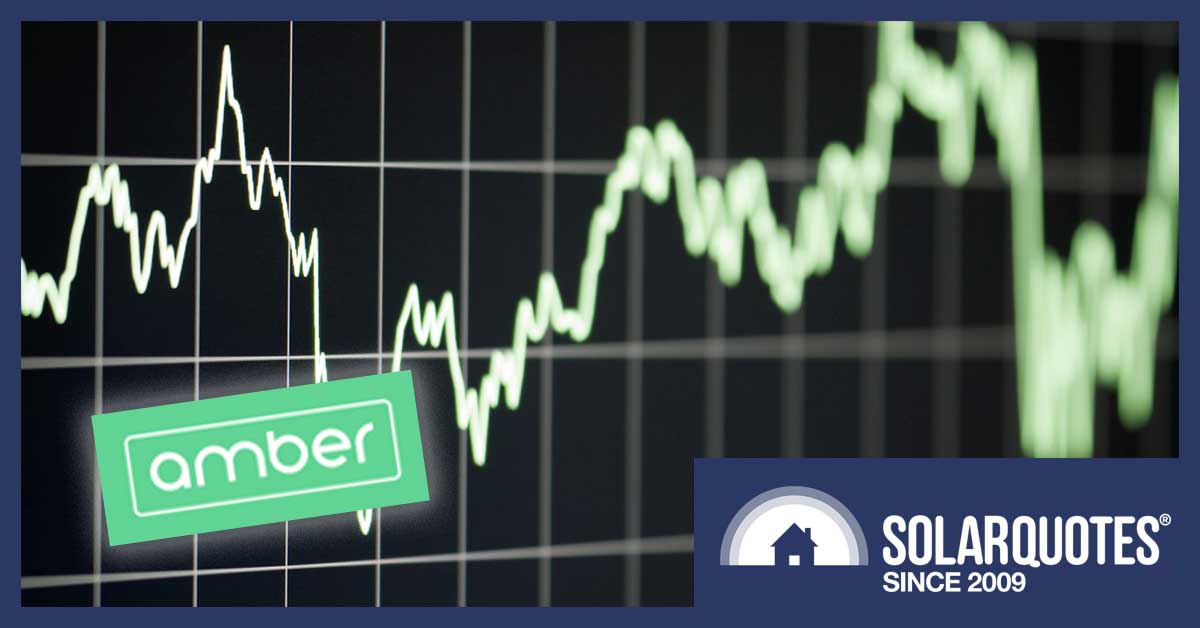
Amber Electric review: low prices and moderate solar feed-in tariff, but could be the best retailer for battery owners.
As I’m sure you’re aware, in this country we pay through the nose for grid power. Electricity bills are so high I’m surprised the police aren’t required to random drug test them.
Using the SolarQuotes electricity retailer comparison tool I looked up the cheapest retail plan available in Adelaide and found it charges 33.4 cents per kilowatt-hour. Add in supply charges for a home that uses 5,000 kilowatt-hours of grid electricity a year and it comes to a total of 38.7 cents per kilowatt-hour.
If you stole a generator from a hospital or orphanage that amount might be all you’d need to spend on diesel to make your own power1. Fortunately for the energy security of hospitals and orphanages across the state, a new, relatively low cost, electricity retailer has just started operating in South Australia. It’s called Amber Electric and is already available in the Ausgrid network that covers eastern Sydney and Newcastle.
They say they can provide electricity in SA for an average of 29.2 cents per kilowatt-hour (37 cents per kilowatt-hour with supply charges).
You may not find this too impressive since it’s only about 4% less than the cheapest plan. But I haven’t told you what’s cool about it yet.
- It’s greener than the usual retail plan. They buy carbon credits to offset emissions for the electricity you buy. In South Australia this costs 0.9 cents per kilowatt-hour. If you subtract that from the price it comes to 36.1 cents per kilowatt-hour, which is 7% less than the cheapest plan.
- They don’t charge you a flat rate per kilowatt-hour. They charge you the real-time wholesale electricity cost – which changes every 30 minutes depending on market conditions.
By tracking the wholesale spot price online you can alter your consumption to use more power when it’s cheap and less when it’s expensive. Amber Electric estimates if you are careful with your electricity use you can reduce what you pay by 3 cents per kilowatt-hour. This would drop the total cost to 33.1 cents beating the cheapest electricity plan available by over 10% — provided you put the effort in.
The bad news is the solar feed-in tariff is lower than what’s available from a number of other retailers offer, so Amber Electric is unlikely to be the most cost effective option for homes that export a considerable amount of solar electricity. But it may suit solar homes with batteries.
Available Locations
Last week Amber Electric was only available in the Ausgrid Network area. The map below shows how it runs through Sydney’s eastern suburbs up to Newcastle and then makes a huge leap inland. Also, it’s shaped like a man in a hat called Barry who is karate kicking:

(Original Image: Ausgrid)
Amber Electric began operating in South Australia on Friday. Now they’re in the best state in Australia they’ll no doubt fix their gaze upon the other eastern states, for on their website they have declared they will soon be coming there. As for Western Australia and the Northern Territory… they’re not going to come there. They have separate grids and are separate markets. The Northern Territory doesn’t even have much of a grid. It’s really just a gr at best. But while NT and WA may not be able to get Amber Electric, electricity from amber is still available from men in tight jeans everywhere.
Cost Breakdown
Amber Electric has interactive graphs giving breakdowns of their charges for the Ausgrid area and South Australia. I’ve included the SA one below and it shows a historical, average cost per kWh every week for a year in South Australia. It includes GST and assumes you make some effort to avoid high prices but don’t get too carried away.
By putting the cost breakdown into a pie chart2 we can see transmission and distribution through power lines is just a smidgen under half the total cost while generation is a little over a quarter.
I tried to use the information above to see how they calculated the daily supply charge, but I became confused because they squished fixed and variable charges together. So I sent Amber Electric an email and they sent me back a spreadsheet giving a breakdown of the daily charge and usage charge. This makes it easy to see exactly what goes into them. Next to “Usage charge breakdown” where it says “Never use power at cheaper times” that means they have assumed the household doesn’t change its electricity consumption to use more when it’s cheap and less when it’s expensive. It doesn’t mean the household doesn’t use power when it’s cheap.
Daily Variation In Wholesale Price
While the graph above shows how the wholesale component has its weekly ups and downs, it doesn’t show the variation that can occur in a single day. I took the graphs below from the AEMO site on Thursday. The first highlights the lowest wholesale spot price over a 24 hour period and the second highlights the highest:
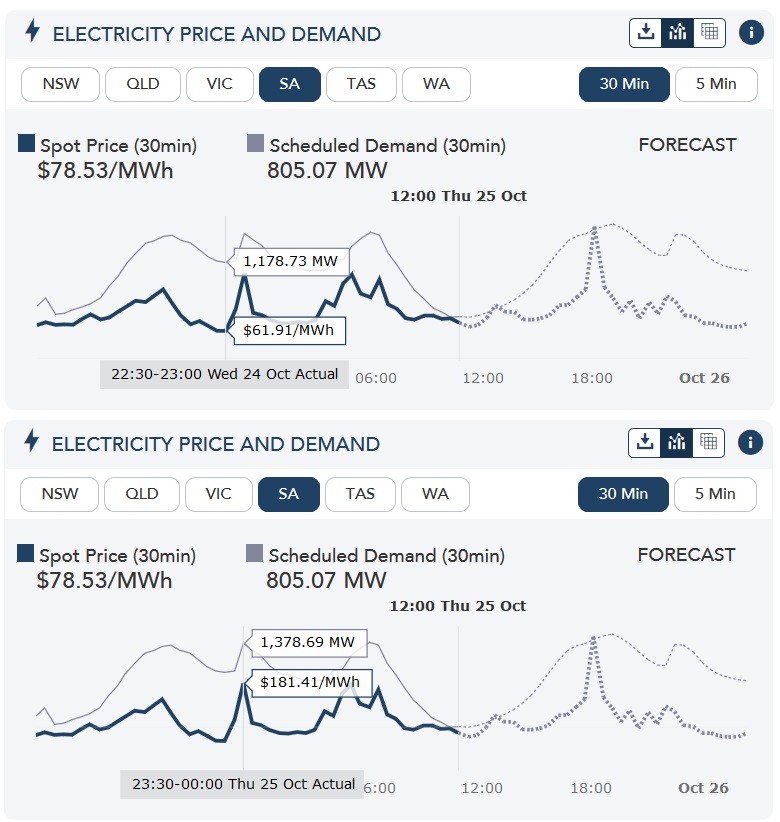
(Image: AEMO)
The lowest price was $61.91 per megawatt-hour, which comes to 6.191 cents per kilowatt-hour. The highest price was almost three times that at $181.41 per megawatt-hour or 18.141 cents per kilowatt-hour. Most people won’t be too worried about a 12 cent difference between high and low prices but at times — often during heatwaves — wholesale spot prices can soar over $10 per kilowatt-hour. At this price most people would consider it worthwhile to cut back on electricity consumption.
Electricity Prices Can Go Negative
It is possible for electricity prices to go negative and in South Australia they sometimes stay negative for hours at a time, as this graph shows:
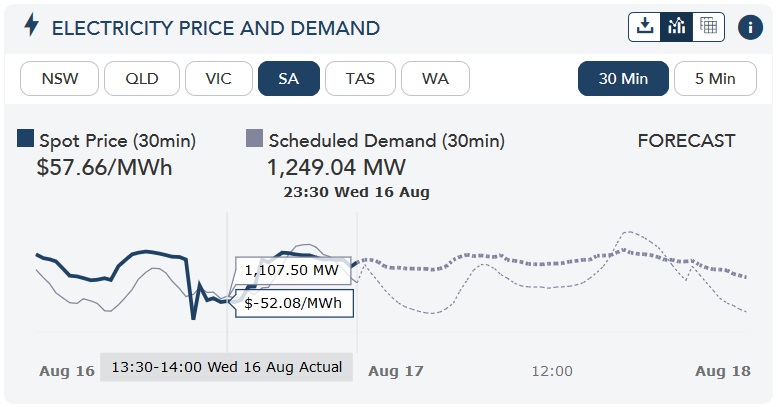
(Image: AEMO)
When this occurs it reduces your electricity bills. It is possible, although very unlikely, for wholesale spot prices to become so negative you would be paid for using grid electricity. The bad news is, because Amber’s solar feed-in tariff is equal to the wholesale spot price of electricity at the time it is sent into the grid, you will have to pay for every kilowatt-hour of solar electricity you send into the grid at these times. Periods of negative electricity prices are rare and often happen at night, so the amount of money you’ll have to pay for solar exports will be insignificant. As more energy storage capacity is built periods of negative electricity prices may disappear.
The Solar Feed-In Tariff Is Not High
Thanks to high wholesale electricity prices, feed-in tariffs in South Australia are the highest of any state. (The Northern Territory is not a state, otherwise their high feed-in tariff would win.) Here are the highest feed-in tariffs offered by three largest electricity retailers in South Australia:
- AGL 20 cents
- Origin 18 cents3
- Energy Australia 15 cents
Amber Electric’s solar feed-in tariff will average less than this as they only pay the wholesale price of electricity at the time it is sent into the grid. They told me in Sydney the feed-in tariff averages 11-12 cents and they expect it to be slightly higher in South Australia. This is better than I would have expected as wholesale spot prices are often lower than this in the hours around noon when solar output is usually at its highest. This graph from Saturday shows the wholesale spot price in the middle of the day for South Australia at only 5.4 cents per kilowatt-hour.
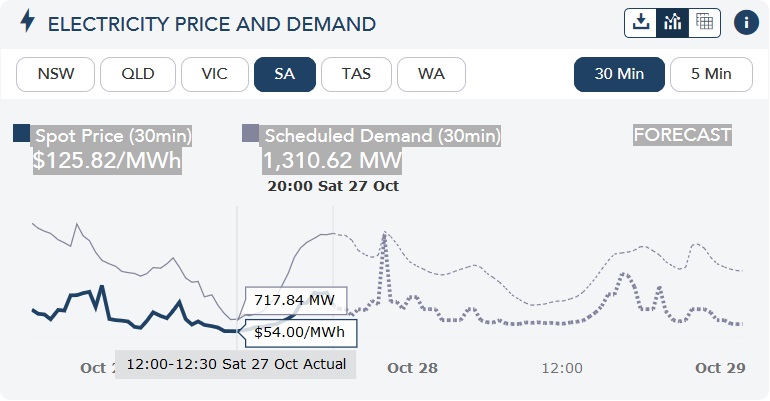
(Image: AEMO)
But wholesale prices are usually higher on weekdays than weekends and the greatest opportunity for solar export earnings will be in summer when solar power output is at its highest and wholesale electricity prices can be very high. Because electricity usually costs more early in the morning and late in the afternoon, homes with east and/or west facing panels will earn more per exported kilowatt-hour than those with north facing solar panels, with west facing panels will earning the most. As more solar capacity and energy storage is built the average amount paid will fall, although it’s likely to fall for all retailers.
Because there are higher feed-in tariffs than Amber’s, if you have rooftop solar power you should take care to make sure you’ll come out ahead. But the majority of homes in South Australia still don’t have solar panels so there are plenty of people who should find it cost effective.
Electricity Plan Comparisons
If a South Australian household has the following characteristics:
- A solar system that is 5 kilowatts or more in size and produces 7,500 kilowatt-hours a year.
- Exports 5,000 kilowatt-hours of solar energy a year.
- Has a solar self consumption rate of 20% and uses 1,500 kilowatt-hours of solar electricity a year.
- Purchases 4,000 kilowatt-hours from the grid for a total annual electricity consumption of 5,500 kilowatt-hours.
Then which plan would be the most cost effective? Looking at the plans with the highest feed-in tariff offered by the ‘big 3 retailers’, their annual bill would be:
- AGL $996 (20c FiT)
- Origin $890 (18c FiT)
- Energy Australia $1,098 (15c FiT)
As you can see, just because AGL has the highest feed-in tariff doesn’t make it the most cost effective choice in this situation. But to compare these results to Amber Electricity we will have to estimate Amber’s average feed-in tariff. Amber Electricity says they expect it to average over 11-12 cents in South Australia, so I’ll use a figure of 13 cents — but I suggest you consider the possibility it will actually be lower. With an average feed-in tariff of 13 cents then the annual cost with Amber Electric in SA will be:
- Amber Electric $917 to $1,037
The lowest figure is for a household that always reduces electricity consumption when wholesale electricity is expensive and the highest figure is if no change is made to electricity consumption habits.
As you can see, in this example, Amber Electric isn’t the best choice. However, if you think your west facing panels will earn you an extra one cent per kilowatt-hour of exported solar electricity, then the annual cost of Amber Electric will range from $877 to $997; so it could be the lowest cost plan, but only if you put effort into changing your electricity consumption patterns.
Batteries & Amber May Get On Together Like A House On Fire
Solar households with batteries export less solar energy because they store some of it for use at night. A battery can also eliminate grid imports during periods of high prices. A smart battery can be charged from the grid when it’s cheap. And finally, a battery can export electricity to the grid for a good feed-in tariff when the wholesale spot price is high. So a solar household with a battery may find Amber Electricity worthwhile, although the battery will need software smart enough to trade its energy on the wholesale market. I know of no residential battery system that can do this yet.
In two years it should be possible to buy and sell electricity on the wholesale market in 5 minute periods instead of the current 30 minute settlement periods. In this case being with Amber Electricity may become even more profitable for battery households
Cranking Up A Generator Could Be Cost Effective
If you have a generator, running it during periods of high wholesale prices could be an effective way to save money. It won’t be environmentally friendly as generators generally have worse emissions than power plants, but you will be reducing the load on the grid and that will help keep costs down for everyone.
Amber Alert — They’ll Tell You When Wholesale Prices Are High
Amber Electricity alerts customers by email or SMS when wholesale spot prices are expected to rise over $2 per kilowatt-hour so they can reduce their electricity consumption if they wish. They are looking at how to further in prove notifications in the future — such as alerting people of negative electricity prices — and are looking at having smart devices automatically turn on or off based on electricity prices.
Smart Meters
To join Amber Electricity requires a smart meter. If you don’t have one they will arrange for one to be installed. You won’t have to pay for this as it’s already included in what they charge and you can leave at any time without having to pay smart meter or exit fees. If you are a renter you do not require your landlord’s permission to have one installed. Note that if you get a smart meter in Sydney’s Ausgrid area they will not let you use a standard tariff. This is because of the two things we were promised electricity privatization would give us — lower prices and freedom of choice — we are allowed neither.
Smart Arses
If you go to the Amber Electric site and start reading you will see they have the temerity to use humour. As you can probably tell from my staid, serious. and mature writing style, I don’t approve of that sort of thing. When I called them their answering machine told me they were busy out the back digging for electricity. That’s obviously ridiculous because, as everyone knows, you make electricity from amber by rubbing it, as this amber boy demonstrates:
Green Option
Amber Electricity automatically buys carbon credits to offset greenhouse gas emissions from the electricity you buy from them. This is built into the price. But if you’re not entirely convinced carbon offsets are effective or you want to do even more for the environment then you can get a green power option of the sort offered by many retailers. This is done by paying an additional 9 cents per kilowatt-hour which is used to buy Large-scale Generation Certificates representing energy generated by wind turbines and solar farms. Even though South Australia already produces a lot of clean energy it is still necessary to pay the same amount as in NSW because by law the green energy has to be in addition to what would otherwise be produced. The cost of Large-scale Generation Certificates is expected to collapse in a year or so which should make this option much cheaper.
Electrification Gamification
The solar feed-in tariff offered by Amber Electricity is not as good as some, but I am still tempted by the the idea of joining them for two reasons:
- They are an electricity retailer that appears to be refreshingly transparent in an industry that is otherwise plagued by obfuscation and trickery.
- I am overconfident I can game the system and come out ahead by organising my electricity consumption to avoid periods of high wholesale prices. During a heatwave I could simply switch everything off at the mains in the evening. I have a couple of solar powered torches and my laptop battery is good for 8 hours. Sure, this means I won’t have any air conditioning, but I’m certain the fact temperatures can now reach 45 degrees after sunset won’t be a problem. I’m sure I’ll be safe. Human body temperature is 47 degrees, right?
Footnotes
- At current prices it takes 38 cents worth of diesel to generate 1 kilowatt-hour of electricity using a 40% efficient generator. But a diesel generator that you randomly steal isn’t likely to be 40% efficient. ↩
- The human eye is very bad at estimating the amount of area covered by a pie chart’s sectors. That’s why I never use them — except when I’m hungry. ↩
- You may see an Origin feed-in tariff of 20 cents when comparing retail plans. This is not a normally available feed-in tariff as it only applies for a limited period of time after you buy a solar system from Origin. ↩

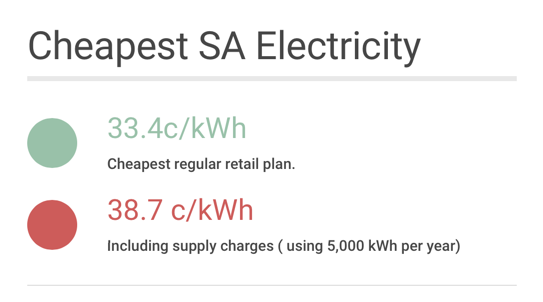
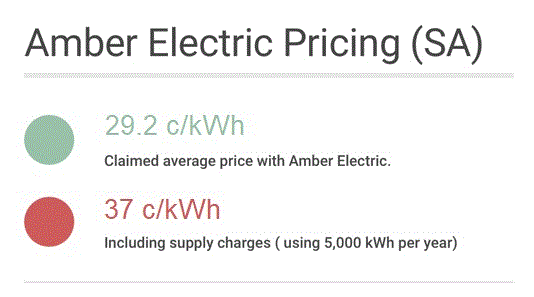

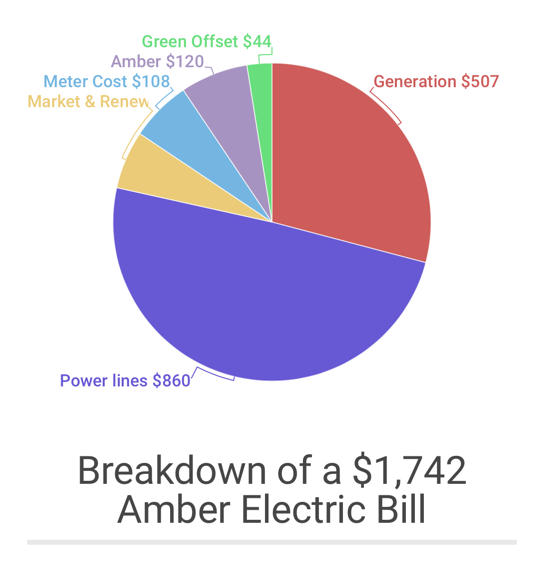
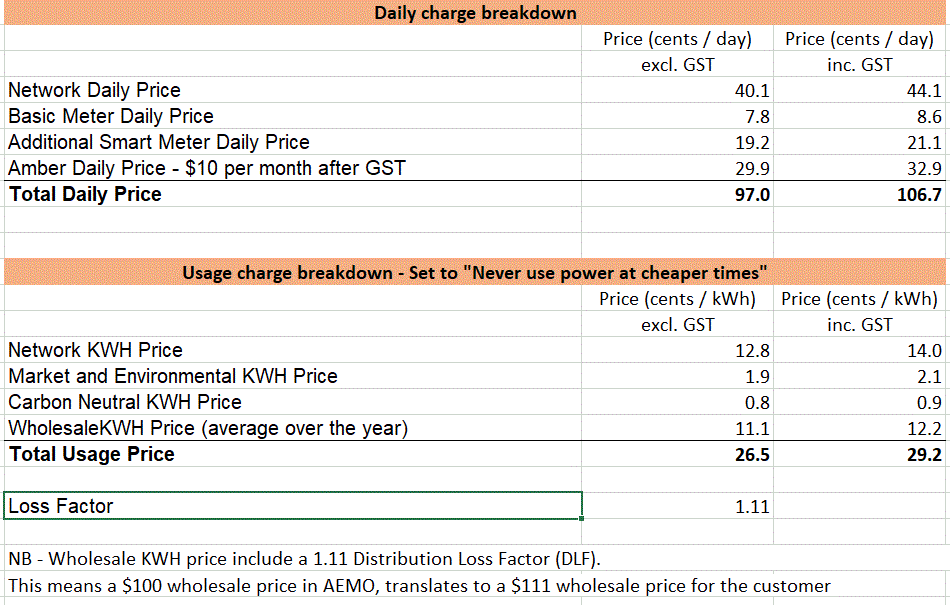
 RSS - Posts
RSS - Posts



Hi Ronald, Guys and Gals, obviously not for everyone. This will be too hard to monitor and to keep an eye out for when the cheapest rate is and there is way too many variables, at the end, I think that you would be worse off than a fixed rate or like mine ‘time of use rate’ which the hours are fixed and you know where you stand, e.g. you know when peak rates apply, off peak rate times etc. etc. if you have solar, then again your feed in tariff is not as good and you can not plan when the electricity is cheapest and use it then.
Whereas, if you have a time of use rate, then you could plan around that and be way out in front.
For e.g. (as you know Ronald), I have an extensive solar system (10.4 k.w.) 2 inverters, and three batteries totalling 24 k.w.of storage. I can use time of use rate to my advantage and be way out in front.
So, if you don’t have a solar system, go get one (the biggest on you can afford, or roof fits) go with an electricity company that gives you the best feed in tariff (at the moment in Sydney it’s 12.5c) and even better get some batteries for storage to use when peak rate is charged (2-8pm) I have never paid peak rate as my batteries do their job to supply me with electricity all night and early morning.
By the way Ronald, I’m still getting credits in the vicinity of about $260.00 per 1/4 and I still sub supply electricity to a tenant (separate building) of mine which I charge him .35c per k.w. used.
Like I mentioned to Ronald on previous posts, I’m on track to have my investment paid off within 5 1/2 years. (another 4 years and I have my full investment back.
Yes $30,000 sounds a lot, but do your maths properly, get on a time of use rate, fine tune your system and bobs your uncle, you too will be getting credits (which can be cashed out at anytime) from you electricity supplier.
Cheers, Tim.
p.s. I have fined tuned my system by, switching on my hot water system during the day (after my batteries are full), and this way my HWS is heated up from my solar system. if there is going to be rainy days ahead, I will switch my HWS back to off peak and heat up during the night. Further more, if I know there will be rainy days ahead, I will force charge my batteries on off peak rate, during the night to use later that evening, so I don’t have to pay peak rate.
So you see with a little planning (and investment) you can turn the tables around on the electricity companies.
I don’t understand the section where you say AGL in SA pay a fit of 20 cents. I’m with agl but they only pay me 7 cents for the first 14? kw then 5 cents.
Meanwhile, in China, domestic electricity is 0.11 cents/KWh. (
https://www.ceicdata.com/en/china/electricity-price ). And like frogs in boiling water, we think that 0.33 cents/KWh is the new normal.
Somebody, either the retailer or producer is price gouging to the extreme.
You do mean $0.33 don’t you?
So all the hysteria about the price of generation is so much clap trap, 75% of the cost is in other stuff, with 50% of the total being in distribution networks. Is there a good detailed analysis of how efficient they are and whether the system is gold plated or has perverse incentives?
Hi, Michael.
My solar panel system installer is convinced that the off peak hot water system should NOT be connected to the solar power system, saying that the tariff is so low that its not worth it.
I guess it depends where you live, the size of your water heater, and what your usage patters are. In QLD, the differential between the hot water T33 rate and the T11 rate is only about 3 cents, and both are above the FIT, so it is still worthwhile to ‘self-consume’ some of your solar production by diverting it to the water heater.
Means ypu usually need to watch your timing of when you do your laundry though. Between 10:00 AM and 1:30 PM is often a good time (only if you have a hot water power diverter also installed of course).
Hi Bosco, If you have solar at your place, you should have two wires that go to your hot water heater, ONE IS OFF PEAK AND THE OTHER ONE IS A BOOST, which is a constant supply of electricity, If you don’t have two + wires, then you must have a small system which is either connected to a constant live wire OR an off peak + wire which comes on at night only.
What I have done with mine is: I have a 20A switch mounted on the cover of the HWS. One side of the switch is OFF PEAK ONLY, and if I flip the switch then it switches over to CONSTANT (which heats up at any time of the day and night till the thermostat is triggered. Now during the day if your home and It’s a sunny day, then you flip the switch over to CONSTANT and WHALLA, you heat up your HWS via your excess solar energy. Most hot water heater draw about 3-3.5 k.w which heating.
Like I mentioned on my previous posts, if you see that there is rainy days ahead, then flip if back to off peak, (however as someone mentioned that it’s not a big difference on pricing), you need to do you maths and work out the best plan to be on and work it to be to your advantage.
Cheers for now, Tim.
Hi Tim,
Thanks for your reply. I’ll do some investigation.
Regards
Bosco
I have a solar hot water diverter system called Blue Catch which I had installed at the same time as my solar panels. It is an Aussie designed system that automatially sends solar power into the HWS. It is connected to the internet and uses some smart logic based on solar production, weather and other variables. It automatically switches over to off-peak if it forecasts that there will be insufficient solar power for water heating.
Hi Nick,
This sounds interesting, how long have you had it ? Has it been working satisfactory ? What are the costs involved ? My system has already been installed, is that a problem ?
Bosco
Hi Bosco, I’ve had it since my solar was installed in February. It works great and is very intuitive. There is also a non internet-connected version. The website is at http://www.catchpower.com.au.
I’m interested in the Amber Electric idea. I have a 10kW array with a Blue Catch solar diverter for the HWS. During good summer days I get 50 to 60 kWh of production and net feed-in of around 20 – 30 kWh (I’ve just put ducted aircon in, which will reduce my excess on some days). With the Blue Catch, my HWS gets to cutoff before midday utilising 8 – 10 kWh per day.
I haven’t gone for batteries yet – I’m not convinced the cost equation is there yet.
I guess I might talk to Amber and get their lowdown.
I don’t understand how the calculator works on AmberElectric. It’s just weird in their calculations.
Let me just state two things.
1. The cost of kWh is not dependent on the fixed daily charge.
2. The cost of the daily supply charge is not dependent on the amount of kWh used.
Right?
Analogy:
1. Petrol costs is not based on the rego cost
2. Rego cost is not based on kms travelled.
Right?
So, one is a fixed cost and the other is variable.
So, here’s my Q
Why does Amber’s calculator show variable changes to the pole lines when I increase or decrease energy used in a period? Isn’t the cost of pole lines fixed?
For my summer bill, I hardly drew from the grid (due to solar and Tesla Powerwall). But I get a bill for daily supply charge despite only drawing about 50kWh over the whole of summer. So, I get charged for 50kWh usage (on ToU – which the majority was off-peak) plus the daily supply charge ($0.97/day). Fortunately, my solar exports was high enough to pay for the daily supply charge, pay for the usage and still be in credit.
Now, for my last winter bill, I drew 2000kWh (mostly off peak). Yet, bingo, my daily supply charge is exactly the same as the summer bill. So, that proves my point the cost of the pole lines charge in Amber electric calculator is wrong.
I need to talk to Amber how their pricing works and why they also have a meter cost. I don’t have a meter cost on my bill. Just daily supply charge (fixed), a usage charge (ToU) (variable depending on season), and FiT (variable depending on season).
So, what I want to know is from Amber and if anyone else concurs that how I actually read their offering is this.
With a SmartMeter, they take 30 minutes reading. If I drew power from the grid, I would be charged the wholesale rate for the time period that is published on AMEO’s website what the 30min spot price was for reach of the 48 periods in 24 hours (24 x 1/2hr = 48 readings). That is then added to the daily supply charge (which is about $0.97/day) plus Amber’s monthly fee (about $0.32/day). Now, at the same time, if I exported any solar, I would also be paid the same spot price for 30mins that my solar exported to as it was for power drawn from the grid.
So, that with market cap of $14,000/MWh or $1400/kWh, it’s possible one could earn $1400 at the right time just exporting 1kWh of solar at the time when the AEMO’s spot price hit the market cap (albeit it would be very rare).
So, how is that Amber say their per kWh incorporates the total cost of everything when we know that kWh costs is variable and the distributors’ supply charge is fixed (regardless how much ones draws from the grid or exports to the grid).
Something doesn’t add up here….. it’s either misleading, miscalculated or hiding extra charges in the fixed costs to mark up the wholesale price to an almost “retail” price.
If it is indeed it’s true that they truly offer a variable spot market price of electricity used in 30 minute periods as published on AEMO’s website (where you can actually see what the prices are) and a fixed cost daily supply charge and their monthly fee, then it’s a very interesting proposition because one could effectively use the grid at low cost times and export at high cost times.
That means each day with my smart meter data, I could apply the AEMO’s wholesales in a spreadsheet to work out exactly what I pay for. Sure, it’s highly variable. But the fact is, that it’s wholesale prices one is paying for the energy portion of the bill. This would shake the retail market up for sure…..
Typo in my last post…. it should read $14/kWh, not $1400/kWh. Forgot to take out all the three zeros from Mega to kilo conversion. But, it’s an impressive price for 1kWh @ $14!
Hi Graham – I think the missing piece here is that the ‘daily charge’ is only some of the network costs. There are also network costs on a per kwh basis. The car analogy here is that you pay rego to be able to use the roads and then you pay fuel excise to contribute to road costs based on usage.
Not all network costs are in the ‘daily charge’ – so you won’t see the daily charge change for winter vs summer per your example but total network costs will change based on your usage. It must be buried in your variable usage somewhere.
In short, if the wholesale price is $40/Mwh for an hour and you use 1kwh, the price is not going to be 4c for that hour, it’ll be much higher because there is a c/kwh network cost to add on top.
I am not an amber customer yet (just signed up) but have experience with retail tariff structures. Sounds unfortunate that Amber do not provide the transparency on their calculations to help you understand better what’s going on. Hope my explanation helps unscramble the omlette.
Been a while since I read this post…
But I got more answers from Amber when I queried them and they gave me a very detailed breakdown and they said they would try and fix their online calculator how they charge their rates to make it clearer but with different distributors, it would be very complex but not impossible. I guess if they could have a sliding function to adjust the wholesale prices portion (like online finance calculators do with varying interest rates with everything else preset). AEMO data is available 24/7, so one can align their smartmeter data to see how it comes out vs their own retailer.
Here is the breakdown:-
Yes, indeed, they do pass the wholesale costs of electricity (according to the AEMO market prices) but the following is also added to the usage charges.
1. the network usage charge from the distributor’s per kWh rate – highly dependent on the distributor, usually fixed at about 9c/kWh for flat rate or tiered if on ToU (from 7.5 to 12c/kWh). (one would need to look at the distributors pricing for their fixed and variable rates).
2. Market/Environment costs about 1.7c/kWh
3. Carbon neutral offset costs, about 1.3c/kWh
So, this comes in about 21c/kWh. (4 components that make up Amber’s kWh rates). Extremely variable due to the AEMO’s 30min spot price.
But, Amber will cap it at around 35c/kWh max to protect consumers from high peak periods (average out over a month).
But that’s not all…. the fixed charges are:- (regardless how much kWh is consumed).
Daily Supply charge – about 89c/day – made of the following components:-
a. Network fixed charge by the distributor – about 35c/day
b. Metering charge – about 25c/day
c. Amber – 29c/day (covered by $10/month fee) (account keeping fees basically)
Then….
Solar feed in tariff – subject to AEMO’s wholesale prices but Amber will pay a top-up if it is too low. (usually up to an averaged retailer voluntary FiT)
But if the market pays $14/kWh, you can possibly get that for solar export but extremely rare event.
So for me, it’s not worth it. My ToU Off peak tariff is lower than what could be had at AEMO’s wholesale price and all the other bits added. Even, if the wholesale price was $0.00, I would still have to pay a minimum of 13c/kWh (parts 1, 2 and 3 of the usage costs listed above). And there’s not many periods when prices are $0.00/MWh on AMEO.
The average AEMO price has been around 12c/kWh over a month.
These prices are ex GST.
At this stage, not worth it. Too much work to look at when prices are going to be low to plan one’s usage pattern.
I don’t understand how a distributor can charge a usage charge, they don’t actually generate electricity, they distribute it. Interesting given the fact the distributors don’t burn any fuel to distribute electricity, they do incur energy losses in transformers and line losses. This is like the motorways, an additional charge/toll to use the motorway even though we already paid rego and fuel excise tax that go towards roads. Another charge added.
How can a distributor charge for usage? Their job is deliver the voltage to the premises. How much energy is consumed by the premises is a different thing altogether. Distributors don’t burn coal, gas, or use hydro/solar to deliver power, they have zero fuel costs yet they charge a kWh usage rate? So, their model is to ensure the consumers use as much as they can because it means extra revenue to them as well as the generators. Very very odd. Unless they are using that to cover the energy loss incurred in all their equipment and the consumers pay for that loss of energy in the distribution process.
Solar customers don’t pay the distributors’ usage rates if they use their own solar power but at the minimum, the daily supply charge (fixed) will be collected for standing costs (the poles and wires). Basically, we are paying to get a grid reference voltage so the solar inverters and batteries can interact with.
Imagine, if there was a rule/law so that distributors can not charge usage per kWh consumed by a customer? Would that mean they will jack up their daily supply charge higher to cover the shortfall in revenue. Which sort of explains why some distributors charge higher rates than others because their customer base is smaller so they recover some of that costs via usage (kWh) rates, even though they have zero costs in generating the electricity. The distributors are truly the middle men in this game.
There is no difference in winter or summer charges (for the Endeavour distribution area).
Lucky, I pay very little in usage charges since I have solar and battery. Tough luck for Endeavour, they don’t get any usage charges out of me but they still do get the fixed daily supply charge of 35c/day 🙁
I actually gave Amber 2 weeks of raw data from my smart meter data download and they were good enough to work out what it would have cost if I had been with Amber using their real AEMO data based on the 2 week dates. The results was that I would have been $14 worse off for those 2 weeks if I had been with them vs my normal ToU tariff. Extrapolating that over a year would have been at least $360 worse with Amber.
The promise of passing wholesale rates sounds good but in reality it may not work out for some.
On top of that, my solar FiT is 21c, Amber’s average FiT is about 11c. So, that makes it even worse.
Thanks Graham – that’s really useful! Looks like Amber is unlikely to be such a good deal for most people after all.
OK…so slower reading of the whole article and I refer to the breakdown costs in the article that Ron asked for.
Now, according to Amber’s website, they say they pass through Wholesale prices with no mark up.
Their words:-
“Instead of making up our own prices, we just pass through the real wholesale costs of getting you electricity without any mark-up”
So, why in the breakdown costs, Amber lists a wholesale price for kWh and a Network kWh price?
Now, nowhere can I find on Amber’s website, that they say, they add an additional kWh price on top of the wholesale price to arrive at a total kWh price unit. They said they pass through wholesale prices. In return for doing so, that they be paid $10 month.
I smell a rat in their pricing structure and just another way of obfuscating their true price models.
Now, it is a known fact that the bills are made of two parts – fixed and variable costs. Again, I played around with their calculator. Their pole/lines costs varies if you adjust usage figures (1p/2p/4p). This is a red flag, because pole costs are fixed regardless how many kWhs one uses.
Nope, don’t accept their premise on passing on wholesale prices. It’s misleading to say to the say the least.
Unless I’m missing a fundamental part on what they’re advertising. I’m currently not in their catchment area (Endeavour Energy) which is next to Ausgrid. So, unless Ausgrid have some weird pricing structure which I highly doubt and they are similar to Endeavour’s (I do know that Ausgrid’s daily supply charges are higher for all retailers compared to Endeavour’s).
Hmmm… a space to watch when Amber doing come to the Endeavour Energy region. When they do, I will hardpress them for the facts what the real costs are. But for now, I don’t buy it.
This is all bullshit.
I have tried all the suppliers in my area and there is less than $100.00 PA between any of them.
Since the government started crowing about cheaper electricity my new rate from AGL has gone up over 20%
yep that’s right and the reason why is the governments truth in pricing.
ALL pay on time discounts have been bought down from a maximum of 28% to 8%\My new rate from September wiil be roughly 1 to 2 cents a KWH dearer and my solar buy back reduced from 11 cents per KWH to 10.2 KWH.
How about getting to the bottom of these government noises and what the actual result is ?????
I’ve been with Amber since Dec18. At the start I was seeing some high FIT for the summer moths but as the season has progressed the FIT average for the monthly bill has crashed to 0.0425 in September.
Now I’m seeing cases where the are days where the Amber dashboard is telling me that I’m getting Negative yield figures, i.e. it’s COSTING me to feed in to the grid. The SA Power site tells me that I generated 18.1kWh on 02 Oct, but the Amber Solar Exports page has me at -$2.30 for that day.
The advice was to switch off the inverter. Sure this will save me from the Negative FIT, but wasn’t the whole reason for getting Solar in the first place was to provide green energy to the grid to reduce emissions? It just feels wrong to withhold putting energy into the grid.
I guess if this occurs more often, then the case for getting batteries is increased, but I’m not sure how much this tips the balance.
So, I’m beginning to think that my experiment with Wholesale power has not been a great success, and I eagerly await the return of the Compare Energy Retailers page so I can explore the options.
If you are willing to sacrifice a little bit of money for the environment then just leave the inverter on. I’ll thank you for it in advance:
Thanks Jean-Pierre!
As electric cars and other forms of battery storage become more popular and as more state interconnectors are built, I expect periods of negative electricity prices will eventually decline. Someone with an electric car and Amber could clearly benefit from charging it during periods of negative prices and if it has the ability to discharge to the grid they could make a lot of money when the wholesale electricity prices are over $10.
Amber – Buyer Beware
If you are in Vic. on a TOU tariff, you really need submit a current electricity bill and get Amber to give you an estimate of their price. They cannot access off-peak data and will be calculating on peak wholesale prices if you have a smart meter. I was on a TOU tariff with Tango, 80 hrs/week peak & 88hrs/week off-peak and it will cost me $0.12c/kWh more for off peak, which most of my load was on, with them. So now looking to move my energy away from them.
John